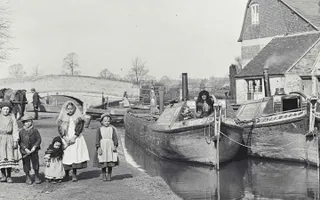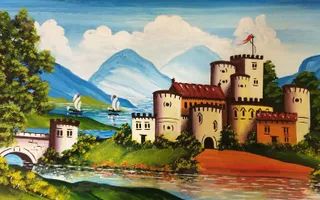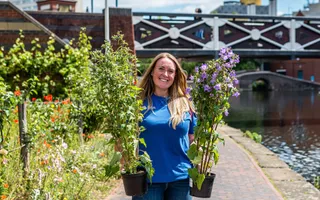Roses & Castles is the colourful canal folk art that was used to decorate working narrowboats in the 19th century.
Its title is somewhat misleading; although both roses and castles feature in the designs, so too do a number of other flowers (sometimes real, sometimes imaginary), cottages, churches, rivers and lakes - anything in fact that could be part of a romantic landscape.
Roses & Castles covered virtually everything in or on the narrowboat – including the vessel itself. The drinking can, the horse's harness, doors, fitted furniture, lamps, anything and everything was decorated with bright and cheerful chocolate-box designs.
How did Roses & Castles come about?
Remarkably, the Roses & Castles movement took root and flourished at a time when other traditional crafts and trades were fading in the light of the Industrial Revolution. In fact, Roses & Castles became so intrinsic to the boating environment that it is still going strong today.
No-one knows exactly where the Roses & Castles movement originated from. There are obvious links with traveller culture and their elaborately painted caravans, but historians have also identified similarities with folk art from Germany, Holland, and even Asia. Wherever it came from, the reason for its popularity and growth is certainly tied to the limited size of the boat cabin, the pride of the boat people and the competition between the canals and the railways.
Competition between the canals and the railways
Money was short for the boatmen – especially once the railways starting springing up – and it made sense for them to bring their wives and families on board to work the boat in the place of a crew. At the same time, the advent of the railways limited any new investment in the canals and consequently neither the canals nor the working narrowboats were able to benefit from further development.
The cabins, the living quarters of the boats, were tiny and looked set to stay that way.
Pride and solidarity
The wives and other women folk of the boatmen brought domestic pride and accomplishment onto the boats with them. Their space was limited, and this made them even more determined to make every item bright and attractive.
Added to this was a desire to appear as cultivated and refined as possible in front of Victorian land-dwellers who had a tendency to look down their noses at the itinerant bargees with their dirty cargo and often illiterate children – being always on the move made school attendance difficult.
With brightly painted romantic landscapes adorning every available surface, crocheted lace hanging in the cabin and everything scrubbed and polished, the boat men and women displayed their pride in their trade and created solidarity with their fellow boaters.







